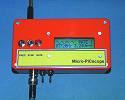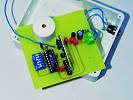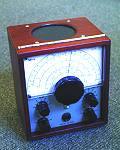
![]() MICRO-PIC
Scope
MICRO-PIC
Scope
This fabulous PIC 16F876-based probe offers frequency and voltage readout,
with an approximation of the waveform under test. Designed mainly for
audio signal finding, very straightforward to build. Free source code
available from our FTP site. Note: this design is not a microscope!
![]()
![]() In the May
2000 issue (P.382) we advised that the part number for the orange case
should be 281-6841 and not as shown.
In the May
2000 issue (P.382) we advised that the part number for the orange case
should be 281-6841 and not as shown.

![]() Garage
Link
Garage
Link
Ever left the garage door open all night? Me too! Our project sends a
brief radio signal every 45 seconds into the house, generating a warning
tone to warn that the door is open. Uses 418MHz or 433MHz pre-built RF
modules. Photocell assures night-time only operation. Switch-activated
by garage door position.
Teach-In 2000 (Part 6) - Logic gates, Binary and Hex Logic
Essential educational info. for the novice using our free interactive
PC software and practical experiments to establish the foundations of
electronics. Our major tutorial series, not to be missed!

![]() High Performance
Regenerative Receiver (Part 2)
High Performance
Regenerative Receiver (Part 2)
Constructional details are provided of our retro-look high quality
receiver, covering 130kHz - 30MHz. The receiver has a clear, pleasant
tone and output is more than adequate.
![]() In June
2000's issue (P.468) we reported that some examples of the 2N3819 f.e.t.
performed badly or not at all. The author advised that this could be cured
by increasing R5 to 15k.
In June
2000's issue (P.468) we reported that some examples of the 2N3819 f.e.t.
performed badly or not at all. The author advised that this could be cured
by increasing R5 to 15k.
In Jan. 2001 issue (P.31), note that on P.301 April 2000 issue, the main
receiver printed circuit board copper foil (Fig. 5) as shown: all the
leadout pads for the dual-gate MOSFET (TR3) are connected together by
the circular track just above the p.c.b. # number, which shorts out all
TR3's pins and stops it operating. To remedy this, the thin copper circle
should be cut away (e.g. with a blade), and the thicker tracks can be
trimmed back to the first sodler pads if you wish.
Technology Timelines (3)
Communications and Related Technologies 1900- 1999
Our intrepid time travellers Clive "Max" Maxfield and Alvin
Brown continue to outline many major technological breakthroughs of the
past century, this time dusting down telephones and television sets, satellite
development, the magnetron and the microwave. And the Internet too (hurray!)

Ideal for beginners, this Starter Project enables a secondary flashgun to be triggered by the main flash, using an optical-sensitive phototransistor. Perfect when no sync. socket is available. Easily built using ordinary stripboard.
Also in this issue: Circuit Surgery continues with an inside-look at op.amps, Net Work - The Internet Page - looks at domain names, Ingenuity Unlimited offers more reader's ideas, and there's a bumper Readout page of readers letters.